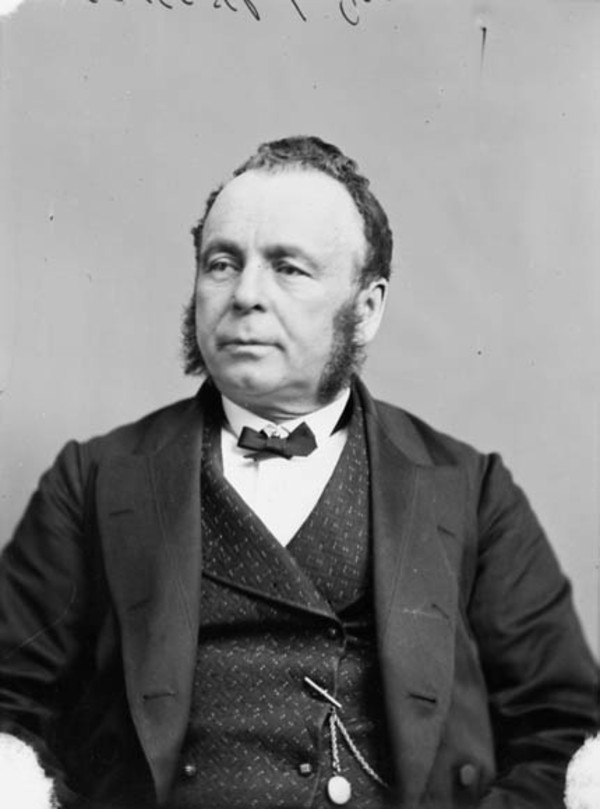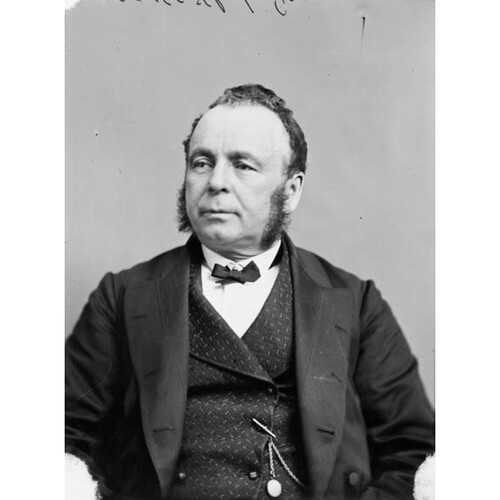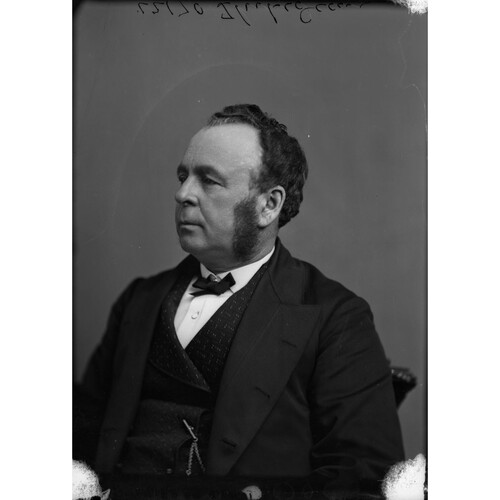THIBAUDEAU, ISIDORE (baptized Pierre-Isidore), businessman and politician; b. 30 Sept. 1819 and baptized the same day in Pointe-aux-Trembles (Neuville), Lower Canada, son of Pierre-Chrisologue Thibaudeau and Émilie Delisle; m. 4 Sept. 1849 Laure Drolet in Charlesbourg; d. 18 Aug. 1893 at Quebec.
The Thibaudeau family, who were of Acadian stock, engaged in commerce at Cap-Santé. Pierre-Chrisologue, himself the son of a merchant, soon acquired an influential position in the community, in both business and local politics. Married in 1818, he and his wife Émilie had at least 13 children, including Isidore, Joseph-Élie*, and Joseph-Rosaire. Most of their daughters married merchants from around Cap-Santé or Quebec. Father and sons pursued parallel careers in business, politics, and administration.
Late in January 1836 Isidore Thibaudeau was apprenticed for five years as a low-paid clerk to Masson, LaRocque, Strang and Company, the Quebec branch of Robertson, Masson, LaRocque and Company of Montreal. The arrangement came as no surprise, since for many years Isidore’s father had been a good customer of the firm, which imported dry goods wholesale and exported potash and wheat. The business, founded in 1803 by Glasgow brothers William and Hugh Robertson as Hugh Robertson and Company, had in 1810 set up a branch at Montreal, with William in charge of the Scottish operation and Hugh of the Lower Canadian one. In 1812 they were joined by a young clerk named Joseph Masson*, who became a junior partner and, on Hugh’s return to Scotland in 1815, was made a senior partner at Montreal. Having conducted their affairs at Quebec through agents, Robertson, Masson, LaRocque and Company set up a branch there in 1830, with John Strang as manager. After Strang’s death in 1841, Charles Langevin, Masson’s friend and trusted associate, who in effect had been his partner since 1831, managed the Quebec operation himself under the name of Masson, Langevin et Compagnie.
Thibaudeau served his apprenticeship, therefore, in an enterprise of the first rank and under the expert guidance of Langevin. He gradually gained his supervisor’s confidence, and from 1841 was entrusted with increasing responsibilities during Langevin’s frequent trips to England. In the winters he undertook to collect moneys to be advanced to merchants in town and countryside, and thus made direct contact with clients. Joseph Masson’s death on 15 May 1847 led to a reorganization of the firm. The Robertsons had already retired, and neither Masson’s sons (in particular Wilfrid) nor Langevin’s son had enough experience to take it over. Langevin and Masson’s heirs agreed to maintain the business by bringing in three new partners, Henry Thomas and Jean-Baptiste Bruyère with Wilfrid Masson at Montreal, and Isidore Thibaudeau with Charles Langevin at Quebec (under the corporate name, there, of Langevin, Masson, Thibaudeau et Compagnie from 1 Dec. 1847). By the age of 28 Thibaudeau had risen to a position of strategic importance in a firm that was in the process of changing hands. A scant five years later Langevin retired on his private income and Isidore became the sole partner at Quebec in Masson, Thibaudeau et Compagnie. In 1856 Wilfrid Masson left the Montreal branch, which then became Thibaudeau, Bruyere et Compagnie. His departure was followed in 1859 by that of Jean-Baptiste Bruyère, with the result that the entire business fell into the hands of the two men hired as clerks 25 years before who were now partners in Thibaudeau, Thomas and Company at Quebec, and Thomas, Thibaudeau and Company in Montreal.
By the beginning of the 1860s Thibaudeau was worth between $150,000 and $200,000. With annual sales of $400,000, the Quebec firm overshadowed all its competitors and enjoyed a first-class credit rating. Unlike Masson and Langevin, Thibaudeau succeeded in bringing several of his brothers into the company, first as clerks and then, in 1868, as partners. Joseph-Rosaire took charge of the Montreal house, along with Henry Thomas and Esprit-Anaclet Généreux, a clerk elevated to partnership; Alfred helped Isidore at Quebec, and later in Manchester, England, where Thibaudeau and Thomas had set up a subsidiary in 1868. The firm was beginning to take on the character of a family business. It continued to widen its circle of customers, cautiously granting them credit, as settlement spread from the area around Quebec into the regions of Bois-Francs, Lac-Saint-Jean, and Bas-Saint-Laurent. In the absence of company archives, it remains difficult to estimate the extent and volume of its operations.
The rapid increase in Thibaudeau’s financial base enabled him to diversify his interests. He was part of a French Canadian business and professional élite that was gaining recognition and gradually initiating joint ventures. In 1848 he had joined Guillaume-Eugene Chinic*, Ulric-Joseph Tessier, François Vézina*, Louis-Joseph Massue*, and others in organizing the Caisse d’Épargnes de Notre-Dame de Québec (incorporated in 1855 as the Caisse d’Économie de Notre-Dame de Québec), and from 1858 in establishing the Banque Nationale. A director of the Caisse d’Economie from 1855 to 1893, he was its vice-president from 1876 to 1893. He helped develop the Banque Nationale, as a founder, acting director, director (elected 25 April 1860), vice-president from 1875 to 1879, and president from 1879 to 1889. He became one of its major shareholders, while retaining his shares in the Banque de Québec. According to historian Ronald Rudin, Thibaudeau was an extremely conservative administrator who relied on the declining lumber trade and made no effort to open new branches in the period 1875–93. He was severely criticized by groups of more aggressive shareholders, right up until the time he left the bank in 1889. He occasionally did become involved in railways, including the Grand Trunk, the Quebec and Lake St John Railway, the Levis and Kennebec Railway, and the Quebec Central Railway.
On 4 Sept. 1849, shortly after becoming a partner, Thibaudeau had married Laure Drolet at Charlesbourg, and the young couple moved into a house on Rue Saint-Louis in Upper Town. In 1855 he bought a large three-storey free-stone house on Rue Sainte-Geneviève at a bargain price from a merchant who had gone bankrupt. Between 1849 and 1862 the couple had ten children, six of whom died before the age of eight. Two of the others left no descendants, and only the two youngest, Laure and Alfred-Arthur, outlived their father. Exhausted and perhaps frail, Laure Drolet died on 1 Dec. 1862 at the age of 32. Thibaudeau never remarried and hired a succession of his nieces as servants, each later remembered in his wills.
In 1863, following the example of his younger brother Joseph-Élie, Thibaudeau went into politics. A liberal of stronger stripe than his brother, he was invited to join the new cabinet formed on 16 May by Antoine-Aimé Dorion and John Sandfield Macdonald*; he became president of the Executive Council and the representative within cabinet for the Quebec region. His position as a minister, his promise to settle arrangements to repay loans made to victims of the Quebec fire, and his substantial financial resources enabled him to win an election in Quebec Centre on 15 June, defeating Conservative incumbent Georges-Honoré Simard*. Having more talent for business than for politics, he played an inconspicuous role within the ministry. He was seldom present for parliamentary debates, except on a few occasions when he gave rather inept replies to accusations about the loans to fire victims or about the potential conflict of interest between his directorship in the Grand Trunk and the government’s policy of assistance to the company, then in financial difficulties. When the government fell on 29 March 1864 he was relegated to the obscure ranks of the back-benchers, where he remained until confederation, a proposal he voted against, along with the radical liberals.
Thibaudeau served on the Legislative Council of Quebec uneventfully from 2 Nov. 1867 until 21 Jan. 1874. When a general election was set in motion by the federal Liberal government of Alexander Mackenzie, which had come to power in 1873 in the wake of the Pacific Scandal [see Sir John A. Macdonald; Sir Hugh Allan*], Thibaudeau resigned from the council to take part in the campaign along with his Liberal friends. He was elected by acclamation in Quebec East on 22 Jan. 1874 and in the house endeavoured to represent the commercial and harbour interests of Quebec. Seldom taking a vigorous part in debates, he aspired to an honorary office, in particular that of lieutenant governor of Quebec, which had become vacant in December 1876 with the death of René-Édouard Caron*. Although he had an enviable position in the party and doubtless had made a substantial contribution to the electoral fund, the federal cabinet chose Luc Letellier* de Saint-Just instead.
When Wilfrid Laurier* was unexpectedly defeated in Drummond and Arthabaska in 1877, Thibaudeau, probably disillusioned, offered him his own riding of Quebec East. At the request of Laurier’s Liberal friends, including François Langelier*, he resigned on 7 Nov. 1877, apparently without compensation, and took part in the campaign that resulted in Laurier’s election on 28 November. Although he was disenchanted by the rivalry between cliques and the infighting within the Mackenzie government, especially on the handling of patronage, he nevertheless ran for election in August 1878 in the neighbouring riding of Quebec, where he was soundly defeated by Conservative incumbent Adolphe-Philippe Caron*. This defeat, attributable in large part to the Conservative landslide, marked the end of his political career.
In the late 1860s the Thibaudeau brothers were involved in all the company’s operations: Joseph-Rosaire in Montreal, Alfred in Manchester, Isidore and Urbain at Quebec. When Henry Thomas of Montreal retired, the firm was reorganized on 1 Dec. 1873, with Joseph-Rosaire in Montreal and Isidore and Alfred at Quebec, under the corporate names of Thibaudeau, Généreux et Compagnie in Montreal, Thibaudeau, Frères et Compagnie at Quebec, and Thibaudeau Brothers and Company in Manchester. When Esprit-Anaclet Généreux also retired in 1875, the brothers remained the sole partners. The Montreal firm became Thibaudeau et Compagnie, with Alfred in charge of purchasing dry goods and fancy goods in Great Britain. The Quebec firm continued to expand and early in the 1880s moved out of premises it had occupied since the 1850s at the corner of Rue Sous-le-Fort and Rue Saint-Pierre into huge warehouses on Rue Dalhousie.
The Thibaudeau brothers gradually withdrew from the business. Urbain died in 1875, Joseph-Rosaire left in 1885, and Alfred, who had replaced him at Montreal, followed suit in 1887, leaving Isidore on his own. On 5 August of that year he took his 26-year-old son Alfred-Arthur into partnership in the firm, putting him in charge of the Montreal operation. On the eve of his retirement, Isidore, who was managing almost single-handed a company now grown very large, must have been thinking of giving up some of the burden of the Quebec business. On 1 Dec. 1887 he promoted Rodolphe Audette, who had been his head clerk and accountant at Quebec and his trusted associate for many years, to the rank of salaried partner. He also fixed the distribution of profits at two-thirds for himself and one-third for his son. When this contract expired in 1890, Thibaudeau brought Roger and Georges La Rue, his nephews and clerks, into partnership, with a salary and a share of the net profits from the Quebec branch. The arrangements made it possible for the company to survive. On Isidore’s death in 1893, Audette and the La Rue brothers could take over the management of the Quebec office, leaving Alfred-Arthur free to concentrate on general management and the Montreal branch.
Thibaudeau’s partnership with his brothers and the increasing age of his children had prompted him to give thought to his eventual death and to make periodic revisions to his first known will, dated 15 Feb. 1870. The will protected his brothers by stipulating that his share of the business could not be withdrawn until the partnership contract expired, or until five years later if two of them wanted to continue in business under another corporate name. With the departure of his brothers, he revised his will several times. On 11 Aug. 1887 he named Alfred-Arthur his principal heir and appointed Audette one of his executors. Within a few months, on 31 October, Thibaudeau apparently decided to leave the company in its entirety to Alfred-Arthur. He bequeathed his personal property to his other son, Charles-François, an easy-going and rather irresponsible young man with little talent for business, who died several months before his father. A clause was then added to Thibaudeau’s will stipulating that Alfred-Arthur was to have his father’s share of the company’s capital, which on 30 Nov. 1885 was worth the tidy sum of $835,048.62. The gift was revoked on 13 Dec. 1888 but was included in his final will, dated 28 Jan. 1890; it made Alfred-Arthur the heir to a business in which Isidore’s share, according to the firm’s annual inventory on 30 Nov. 1889, amounted to $1,032,551.22. Taking into consideration his other properties, investments, and various accounts, Thibaudeau, by the close of his career, had amassed a sizeable fortune: he was one of the small number of French-speaking Quebec millionaires of his day. Throughout its history, his company had enjoyed the highest and most solid credit rating granted by commercial information agencies. In 1893 it employed 27 clerks.
Isidore Thibaudeau died at Quebec on 18 Aug. 1893. His funeral was conducted with great pomp at Notre-Dame basilica on 22 August. There was a funeral procession of at least 1,800 people, and the ceremony was considered one of the most magnificent seen in Quebec for a long time. Among the dignitaries who paid their last respects were Wilfrid Laurier, Sir Hector-Louis Langevin*, and the Langelier brothers, Charles* and François. Nearly a hundred carriages accompanied the body to Belmont Cemetery in Sainte-Foy, where Thibaudeau was interred.
AC, Québec, État civil, Catholiques, Notre-Dame de Québec, 22 août 1893; Minutiers, É.-J. Angers. ANQ-Q, CE1-1, 5 déc. 1862; CE1-7, 4 sept. 1849; CE1-15, 30 sept. 1819; CN1-117; CN1-255; ZC12/1–2. Baker Library, R. G. Dun & Co. credit ledgers, Quebec, Langevin, Masson; Thibaudeau et Compagnie; Thibaudeau, Frères et Compagnie. BE, Québec, déclarations de sociétés (reg. O); index aux noms et copies d’actes enregistrés. Bibliothèque nationale du Québec (Montréal), mss 99, boîtes 35–37. Can., House of Commons, Debates, 1875–77. Le Courrier du Canada, novembre 1877; août-septembre 1878; 19–22 août 1893. L’Événement, novembre 1877; août-septembre 1878; 19–22 août 1893. Le Journal de Québec, mai-juin 1863, novembre 1877, août-septembre 1878. Quebec Daily Mercury, 19–22 Aug. 1893. Mercantile agency reference book, 1859–93. Auguste Béchard, Histoire de la Banque nationale . . . (Québec, 1878). Jean Benoit, “Le développement des mécanismes de crédit et la croissance économique d’une communauté d’affaires; les marchands et les industriels de la ville de Québec au XIXe siècle” (thèse de phd, univ. Laval, Québec, 1986). Bernard, Les Rouges. Canada and her commerce: from the time of the first settlers to that of the representative men of to-day who have shaped the destiny of our country, ed. James Hedley (Montreal, 1894). Caya, “La formation du parti libéral au Québec.” P.-A. Choquette, Un demi-siècle de vie politique (Montréal, 1936). Cornell, Alignment of political groups. Historique de la Banque d’économie de Québec (the Quebec Savings Bank), 1848–1948 (Québec, 1948). J.-C. McGee, Laurier, Lapointe, Saint-Laurent: histoire politique de Québec-Est (Québec, [1948]). Henri Masson, Joseph Masson, dernier seigneur de Terrebonne, 1791–1847 (Montréal, 1972). Gérard Parizeau, La société canadienne-française au XIXe siècle: essais sur le milieu (Montréal, 1975), 283–316. P.-G. Roy, Les petites choses de notre histoire (7 sér., Lévis, Qué., 1919–44), 7: 256–68. Ronald Rudin, Banking en français: the French banks of Quebec, 1835–1925 (Toronto, 1985). Rumilly, Hist. de la prov. de Québec, vols.2–3. [Télesphore Saint-Pierre], Histoire du commerce canadien-français de Montréal, 1535–1893: un souvenir (Montréal, 1894). Tulchinsky, River barons. “Les Thibaudeau,” BRH, 39 (1933): 58–59.
Cite This Article
Marc Vallières, “THIBAUDEAU, ISIDORE (baptized Pierre-Isidore),” in Dictionary of Canadian Biography, vol. 12, University of Toronto/Université Laval, 2003–, accessed January 1, 2026, https://www.biographi.ca/en/bio/thibaudeau_isidore_12E.html.
The citation above shows the format for footnotes and endnotes according to the Chicago manual of style (16th edition). Information to be used in other citation formats:
| Permalink: | https://www.biographi.ca/en/bio/thibaudeau_isidore_12E.html |
| Author of Article: | Marc Vallières |
| Title of Article: | THIBAUDEAU, ISIDORE (baptized Pierre-Isidore) |
| Publication Name: | Dictionary of Canadian Biography, vol. 12 |
| Publisher: | University of Toronto/Université Laval |
| Year of publication: | 1990 |
| Year of revision: | 1990 |
| Access Date: | January 1, 2026 |





